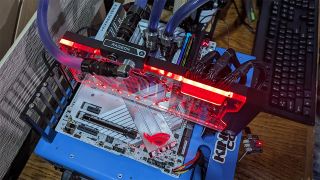Fully unlocked RX 7900 XTX very nearly matches RTX 4090 performance
It takes a hardware mod and serious power though.

In the weeks and months before the launch of AMD's Radeon RX 7900 XTX, enthusiasts were hoping AMD's graphics cards could go toe to toe with the best Nvidia had to offer. In the end, the RTX 4090 took this generation's gaming crown. However, it's clear AMD made a conscious decision to limit the power consumption of the XTX, leaving us wondering just what AMD's Navi 31 chiplet GPU was ultimately capable of.
That question has been answered, thanks to a post by user jedi95 in the AMD subreddit. Jedi95 took an Asus TUF Radeon RX 7900 XTX and modded it to eliminate the card's power limit. The mod involved connecting an Elmor Labs EVC2SE to the I2C bus on the GPU's PCB.
After the mod, with no more pesky power limits to worry about, the card was able to achieve a peak GPU clock of 3,467MHz, or more importantly, an average of 3,333MHz. Not bad, not bad at all. That meant the card was able to deliver a graphics score of 19,137 in 3DMark's Time Spy Extreme test. For reference, my RTX 4090 Founders Edition scores 19,540 in the same test, meaning the unlocked RX 7900 XTX is very nearly a match for Nvidia's best.
Of course, the RTX 4090 can be overclocked too. What jedi95's results really show is that AMD could have increased the TDP of the card from its base 355W if it really wanted to.
That's the good news part. The problem with unlocking power limits is, umm, power! The card reportedly pulled a stratospheric peak of nearly 700W (696W to be precise). Given the high peak temperatures inherent to some AMD's RX 7900 cards (the reference cards anyway), it's no surprise to learn that the tested card required water-cooling, and chilled water at that.

Best CPU for gaming: The top chips from Intel and AMD
Best gaming motherboard: The right boards
Best graphics card: Your perfect pixel-pusher awaits
Best SSD for gaming: Get into the game ahead of the rest
We now have a good idea why AMD chose to restrict the 7900 XTX from reaching its ultimate performance potential. A card pulling well over 600W at nuclear temperatures for stock RTX 4090 performance at best isn't exactly what you'd call a win, and it makes sense that AMD optimized performance per watt over performance at any cost.
Other than being a really cool overclock, these results leave me excited for the future. Well, I'm not excited about cards pulling 700W, but the fact that the GPU itself can sustainably run clocks nearing 3.5GHz without liquid nitrogen cooling is a sign that the underlying architecture is fundamentally capable. It's a good advertisement for TSMC's advanced nodes too!
The biggest gaming news, reviews and hardware deals
Keep up to date with the most important stories and the best deals, as picked by the PC Gamer team.
You get the feeling the RX 7900 is just the first step in AMD's chiplet journey. It's no mean feat to introduce a chiplet architecture with a new interconnect and expect it to be optimized on the first try. AMD's boffins are no doubt taking what they've learned from Navi 31 and applying that knowledge to future generation GPUs. AMD will need to be at the top of its game if it's to compete with Nvidia for the next generation's gaming crown. You just know Nvidia will bring something mega to that fight.

Chris' gaming experiences go back to the mid-nineties when he conned his parents into buying an 'educational PC' that was conveniently overpowered to play Doom and Tie Fighter. He developed a love of extreme overclocking that destroyed his savings despite the cheaper hardware on offer via his job at a PC store. To afford more LN2 he began moonlighting as a reviewer for VR-Zone before jumping the fence to work for MSI Australia. Since then, he's gone back to journalism, enthusiastically reviewing the latest and greatest components for PC & Tech Authority, PC Powerplay and currently Australian Personal Computer magazine and PC Gamer. Chris still puts far too many hours into Borderlands 3, always striving to become a more efficient killer.
Most Popular






